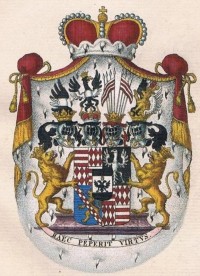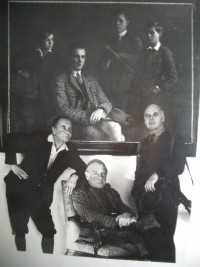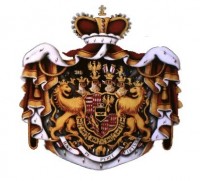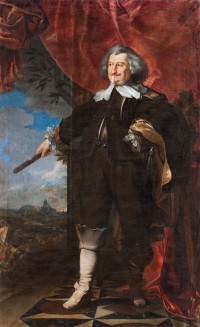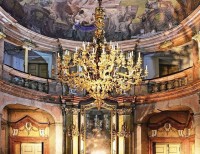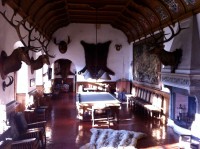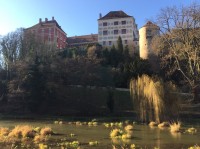The early roots of the Bohemian - Austrian family Colloredo-Mansfeld reach from Friulio in Italy to the Swabian-Baden area at Lake Constance. The 2 brothers Lords of Colloredo- Waldsee Liebhard (Liabardo) and Heinrich joined Conrad the Elder* on his voyage
to Italy in 1025 where he received the insignia of imperial dignity by Pope John XIX. During their stay Liabardo and Heinrich were enchanted by the beauty and pleasant living conditions of the region and decided to settle in the lands of Patriarch
Poppo of Aquileia who was well acquainted to Conrad the II.(*Short About Conrad II. 990 –1039, known as Conrad the Elder, Emperor of the Holy Roman Empire from 1027 until his death, founder of the Salian dynasty of emperors. Conrad served as King
of Germany from 1024, King of Italy from 1026 and King of Burgundy from 1033.)
Liabardo successfully managed and expanded the territory of the Patriarch Poppo for which he was eventually rewarded the castle of Mels near Udine. Liabordo Waldsee now Visconte (Count) of Mels and his descendants expanded and advanced in the
following 250 years through rough times of prolonged struggles for land and power between rich lords and large powers such as the Republic of Venice. In 1305 Wilhelm von Mels was given permission to build what one could call the "Stammschloß" namely
the Family castle Colloredo di Montalbano which is partly still standing even after a devastating earthquake in 1976. Thankfully there is a very ambitious rebuilding and renovation program by the commune of Colloredo.
The noble family Waldsee (in another notation also Wallsee or Walsee) played an important role until the end of the 15th century not only in their home territory of Baden, but also in Austria. The linage died out with Barbara von Schaumburg, born
Waldsee in 1493.
The Three sons of Wilhelm von Mels make up for the three lineages of the Colloredo family:
Line I after Asquino dies out in 1738 with Maria Antonia who married Montecuculi. Although mentionable members are Ludwig who was Minister to Emperor Rudolf II in 1380 and Lelio who was a brave participant in the Battle of Lepanto in 1571,
Lelio and his brothers Friedrich and Ludwig were given the rights to the name Colloredo-Waldsee by Rudolf II in order to preserve and remember the name Waldsee which was now extinct on the male side.Hieronymus was the first Imperial Count
and governor of Silesia around 1630. Probably one of the most well kown figures of the family and in this line is Rudolf, commander (General Field Marshall) and Grand Prior of the knights of Malta in Bohemia, lord of the manor to the castle Opocno
which he purchased in 1635. He was commander in the Battle of Mantua and Lützen where he lost his Leg and suffered a head injury. Nevertheless he recovered well and managed to defend the old city of Prague successfully against the Swedes. He made
outstanding contributions to Prague and even served as Governor there until his death in 1657. He also built the Schönborn palace in Prague between 1643 and 1656 which had an interesting detail, the flight of steps leading to the first garden terrace
were built with a special incline to enable Rudolf to ride into his palace on horseback! Later the palace was inherited by the Schönborn family which is the reason for its present name it should not be confused with the Palais Colloredo-Mansfeld built
in 1735 near the Charles bridge. However Karl Johann Schönborn sold the palace and today it serves as Embassy to the United States. Rudolf is the ancestor of the " Bohemian "Colloredos even though he was childless, but his chosen heir was
in the family namely Hieronymus IV from the Vicardo (Weikhard) line.
Line II , after Vicardo (Weikhard): Due to the sons of one of his descendants namely Ferdinand (ca 1670) the branch with Hieronymus IV is split for the first time into a "Bohemian" and with Rudolf I. into an "Austrian" branch (c. 1880 extinct)the
latter retains a strong connection to the Habsburg's who also controlled Tuscany in those days. Mentionable is Fabricius who was Governor of Siena in 1600, Marchese di Santa Sofia. Fabius Archbishop of Lucca in 1700 and Ascanius (1850)was
a general in the battle of Königsgreatz (Hradec Kralove)
Line III. after Bernardo: Today this is a widespread offspring and bears the name Mels-Colloredo, in Austria, Italy and other countries usually only Colloredo. Here one should mention: Anton Theodore, Archbishop of Olomouc and Cardinal (1780); Francis,
governor of Friuli (1380), Franz de Paula, Minister of State and Court Chancellor of the Emperor (1780).
The house of Colloredo-Mansfeld: Through Italy,Saxony, Bohemia and Austria
The above mentioned Hieronymus IV Colloredo-Wallsee from the Vicardo line was born in Tuscany and married to Caroline Countess Kinsky of Bohemian nobility, He was the first governor of Lombardy and later governor of Moravia and imperial representative
in the Reichstag. he resided with his family in Bohemia and Austria and inherited the Bohemian Fideikommiss after the childless Imperial Commander Rudolf (1585-1657) who as mentioned above was Grand Prior of the Knights of Malta etc.
The oldest son of Franz de Paula Gundakars four sons (three of them remained childless) was Rudolf Josef, Imperial Vice-Chancellor of Empress Maria Theresa he was made imperial prince in 1763 and since then the respective head of the family takes
on the title of prince. He acquired the castle in Sierndorf from count Schallberg in 1756 because it was in the proximity of the imperial capital Vienna. He had 17 children with his wife Gabriela Countess Starhemberg. Franz de Paula Gundakar
I., the eldest son also served as Vice-Chancellor of the Empire as his father but under Joseph II and Leopold I. He married Marie Isabella Mansfeld, Princess of Fondi. She was the last descendant of the Saxon family Counts of Mansfeld, they reigned
at the Dobříš estate since 1633. After their Marriage the name and coat of arms union was decreed by imperial verdict in 1789 . It stated that the name "Mansfeld" should be preserved and subsequently it was added to Colloredo. At this point even a
mistake was made and in some documents the name Mansfeld was spelt with double "n" which explains why some of the family members spell their name Colloredo-Mannsfeld today. Franz Gundakar was thus the first Prince to bear the double name
Colloredo-Mansfeld. His four Brothers remained childless and therefore the name "Colloredo-Waldsee" was unfortunately extinguished although a few important personalities should be mentioned such as Hieronymus V. (1738-1812) the last Prince Archbishop
of Salzburg and Primate (Bishop) of Germany he is known as an important historical personality mostly because of his "discovery" of Wolfgang Amadeus Mozart whom he hired, but he was also the ruler of Salzburg for thirty years. During his reign he
implemented reforms similar to those under Emperor Joseph II. attracting European-wide admiration for his reform efforts in the institutions of education, law, medicine, administration and more, at the time he had to persuade a reluctant population
to change its entire mentality.Further personalities were Johann Nepomuk (Field Marshal), Joseph (Minister of War) and Wenceslaus (Minister of War) all holding important political and economic positions in the late 18th Century.
The eldest son of Franz Gundakar and Maria Isabella was Hieronymus the VI. (1775-1822) he participated in the Napoleonic Wars in 1813 and as a military Leader in the Battle of Kulm( Clumec, Chabařovic). His marriage to Wilhelmine Gräfin Waldstein
also symbolizes an act of reconciliation: During the 30 years war his ancestor, the mercenary leader Ernst Graf von Mansfeld (1580-1626), was one of the fiercest and most successful opponents of the imperial troops on the side of Sweden while her
ancestor Albrecht von Waldstein ("Wallenstein", 1583-1634)was highest commander of the imperial troops. However as known Waldstein betrayed Emperor Ferdinand in his late career and was therefore eliminated in 1634. Subsequently Rudolf Colloredo
was made his successor. There is information that Rudolf Colloredo most likely played a part in the elimination of Waldstein but it's not well documented, he was also one of the few who actually purchased the castle Opočno for 35000 Reichstaler
after Wallensteins elimination. But We know for fact that Wallenstein was not a great friend of Rudolf and he once said to emperor: Ich habe In der Zeit meines Lebens keinen größeren Sancuragine als ihn gesehen und sein Regiment ist in einer
solchen Unordnung und gibt mir mehr zu schaffen als die ganze Armadaas. Meaning something like he was a cowered with a messy Regiment.
Franz Gundakars I. only son, Franz Gundakar II. had one daughter namely Wilhelmine (* 1826) she married Prince Vincenz Auersperg, she was known as the charitable lady of the manor in the novel "Babička" of Bozena Nemcova (1820 - 1862)
After the death of Franz Gundakar II in 1852 the prince title and fidei commis property is inherited by his cousin Joseph I (1813-1895). Josef proves himself to be a prudent businessman being very modern for his time. He invests into sawmills,
breweries and brick factories and builds the Palais Colloredo in Vienna and herewith increases the Family properties significantly. He also acquires the domain of Zbiroh in 1879 which the " European Railway King, "Bethel Henry Strousberg (1823-1884)
had to liquidate in the collapse of his debt-ridden business empire.
After Joseph's death, the Vicard line divides a second time: The younger son, Franz Ferdinand (1847-1925) takes over the Estate in Sierndorf Austria. He and his two Sisters permanently settled in Austria. Other descendants from his marriage to Baroness
Maria Aehrental live mainly in Austria and the USA.The older son Hieronymus VII born in 1842 and married to Countess Aglae Festetics was Imperial Agricultural minister and heir to the Bohemian goods and the palais Colloredo in Vienna. He was also
mayor of Dobříš in order to strengthen the Bohemian interests within the Habsburg Monarchy. Unfortunately he died at a young age in 1881 in blood poisoning caused by stepping on a rusty nail.
The "Bohemian" branch from 1900 until today - world wars and totalitarianism,emigration
With the collapse of the Habsburg Monarchy after the First World War the importance of nobility diminished considerably and members of nobility became residents and citizens of new countries tying to adjust to entirely new social conditions and political
landscapes.
The oldest son of Hieronymus VII, Joseph II (1866-1957) was childless in two marriages he decides to move to the lively postwar Paris and only revisits Bohemia occasionally but he remains Czechoslovak citizen to the end of his life.
The administration of the Bohemian Estates goes to his younger brother Hieronymus VIII (1870-1942) he was married to Bertha Countess Kolowrat Krakowsky. He formerly worked for the K.u.K imperial Navy in Pola and as a Marine-diplomat in Tokyo
and Berlin.
The first land reform in Czechoslovakia after ww1 reduced large estates by up to two thirds and despite financial losses and economic difficulties the family made great efforts to modernize and improve operations of the Properties. After WW1 many
Landowners found themselves in financial trouble, one of them was Charles Henry Count Bardeau owner of the Estate and Castle Gstatt in the province of Styria Austria.Financial difficulties forced him to sell the estate in 1927 thus giving the Bohemian
Czech Branch of the Colloredo-Mansfeld Family a possibility to once again own property in Austria.
By lifting the Fideikommiss in 1940 the property is divided among Hyronymus VIII. four sons.Joseph III. (1910-1989) takes over Gstatt and the Bohemian Family headquarters Opočno,Hieronymus IX. (1912-1998) the domain Zbiroh Weikhard (1914-1946)
the once Mansfeld-Fondi domain Dobříš. Friedrich (1917-1991), remains in Switzerland throughout the "Anschluss" 1938-45. he was supposed to take over the palace in Vienna.
After establishment of the "Protectorate Bohemia and Moravia" by the Nazis the Family was under massive pressure from the occupying power to accept the citizenship offered by the German Reich. An acceptance was considered critical for Adolf Hitler and his regime to bolster and justify the annexation and because the family was of old Austrian decent with german speaking culture. However the offer of German citizenship was ultimately opposed of by all members of the family. The anti Nazi behavior of the family was portrayed to the Germans by a Czech collaborator who was close to the family and told the Gestapo that there is a lot of negative gossiping going on about the German regime!This evokes a verdict by the Gestapo in February 1942 that all the members of the family are to be declared - enemies of the Reich- and all their possessions even in Austria were confiscated in favor of the German Reich. Shortly after there was an equal verdict about Dobříš Castle which becomes the official residence of the Deputy Reich Protector Kurt Daluege (executed 1946)Hieronymus the Elder dies a few months later. Joseph and Weikhard are sent to forced labor, Hieronymus survives the rest of the war unharmed and living in a house with friends of the family. Friedrich joins the Czech exiles in Switzerland and after the liberation of France he joins the Czech legionary troops in England to participate in the final liberation of Europe from Nazi rule.
After the war.
The properties and possessions that were confiscated by the Gestapo are immediately seized again, now by Czechoslovakia! This is due to decrees made by president Beneš. They claimed it had been "German property". At first the brothers Joseph,
Hieronymus the Younger and Weikhard as well as postmortem even Hieronymus the Elder who Deceased in 1942 were deprived of their Czechoslovak citizenship. There were certain conditions for the acknowledgment of citizenship and for claiming back property.
First one had to proof patriotic and anti-German behavior then a separate application form had to be provided. At this stage there was already an increasing communist infiltration of the authorities making it very difficult to succeed however Hieronymus
the younger succeeds initially and he can briefly take over the Zbiroh possessions again. Joseph is jailed and tortured and in fear of his live he prepares his emigration before meeting a supposed requirement of applying for citizenship in his
home district, however he is authorized a citizenship in Prague. Unfortunately the rest is history. Josef emigrated to Canada and established a new life as flower and fruit farmer. Finaly in 1972 he permanently settled in Europe on his Austrian Estate
Gstatt in Styria. He never travels to Czechoslovakia again and unfortunately he dies in 1989 never to have lived or see the Velvet Revolution in late 1989.Weikhard turns very ill in the spring of1946 and rapidly deteriorates in cancer he somehow achieves
to leave CZ for France with a stateless passport in order to be in the care of his mother. He never succeeds to complete his application and dies a few months later.His application remains pending and Friedrich a former army officer and obviously
an undeniable Czech is heir to his brother Weikhard after his death Friedrich undertakes certain formal steps to enforce his and the rights of his brothers. But he as Josef had no illusions, in contrast to many locals who since the end of the
war were still rather optimistic about freedom and expected some rule of law in Czechoslovakia. In 1947 he married and emigrated with his wife to the USA. Joseph was already in Canada with his wife and his daughter Kristina. Hieronymus was still
hanging in and trying to keep Zbiroh. Finally the communist takeover in March 1948 was a fact and he made an adventures escape with the help of some friends by fleeing in the trunk of a diplomatic car.Hieronymus now equipped with false papers under
the name "Girolamo Kapasso" (ironically this stands for "Hieronymus No Passport"), took a route via Switzerland which also leads him to Canada which he adopted as his new home for the next five decades.
After the war Josef the Elder revisited the family headquarters Opočno with its extensive art, weapons and inventory collection which he still legally owned! Naturally he was denied access under some flimsy pretext. Disappointed, shocked and overwhelmed
he returns to France. he decides to give The Colloredo Palace in Vienna to his nephew. Karl Graf Trauttmansdorff, a son of his sister Maria Teresa, who sold it several years later. Opočno castle after more then 300 years of family ownership
becomes one of the prime museums of the CSSR (Czechoslovak Socialist Republic).President Beneš dedicates the Castle Dobříš to the Czech regime friendly writers Association and in the following 50 years they used it for recreationCastle Zbiroh with
its large beautiful park was converted into a secret military base and hermetically sealed off from the outside world, unfortunately it had to endure brutal devastation during communist time.The farmland was merged into cooperatives of giant proportions
and the forests put under state administration. Bohemia disappeared behind an Iron Curtain and most of the Family members considered it a painful fact that would never to be solved, untill.......
The miracle of the restitution.
After the "Velvet Revolution" and the fall of the Iron Curtain in 1989 only Hieronymus (Czech: Jeronym) experienced the first restitution in 1992 when the law was still generous and allowed the return of nationalized property to Czechoslovak citizens
with less complications as today. Hieronymus IX dies in December 1998 his heir is his nephew Hieronymus (Jerome) X., son of his brother Friedrich, he takes possession of Zbiroh and the castle Dobříš. Kristina the daughter of
Joseph III who died in 1989. Is restituted most of the property and regains her Fathers domain Opočno. however after a sensational judgment by the Constitutional Court, the state confiscates the castle again, basically on the same grounds as it was
done before.Now the Czech state claimed again that her Father was a German Collaborator!? even after it was very clear and proven that he was tortured, harassed,humiliated and put to force labor by the nazis And on top of that he had all his property
confiscated!
In 2005, the Constitutional Court restituted the Dobříš lands equally to Kristina and her cousin Jerome. after almost 70 years of interruption most of the Bohemian estates are back in the family.
Unresolved remain until today the process of Opočno and the inventories of the Castles. Although just recently (18. March 2014) the Czech Constitutional court reopened the case and hopefully justice will prevail at last.
